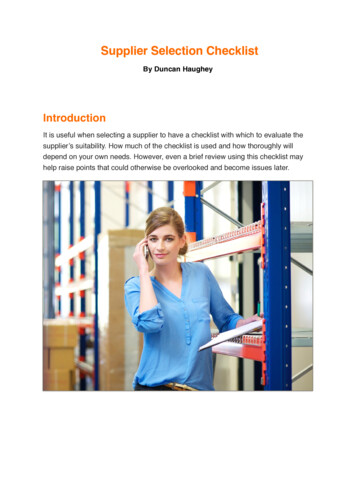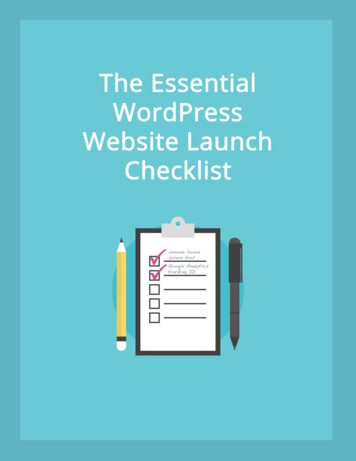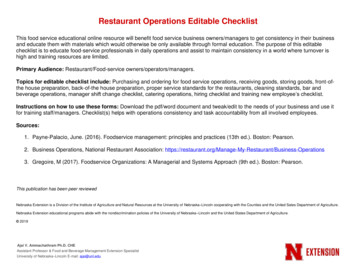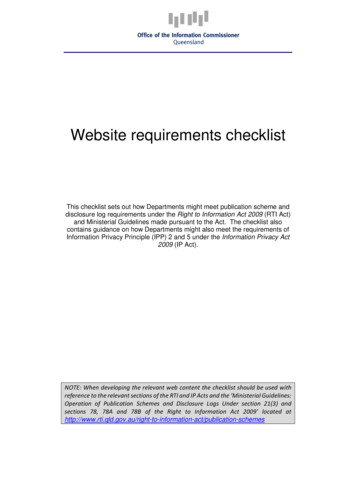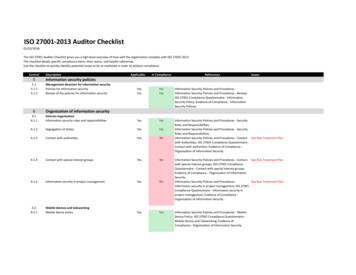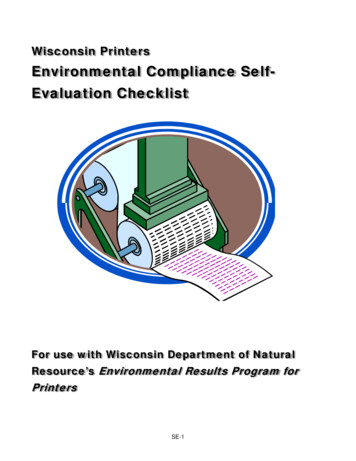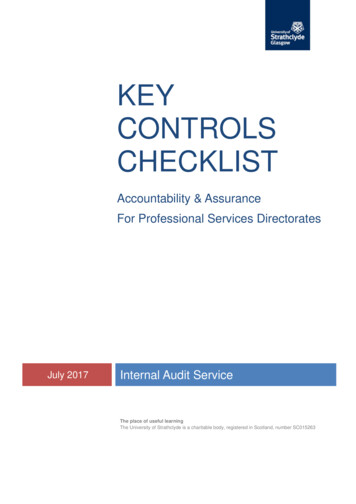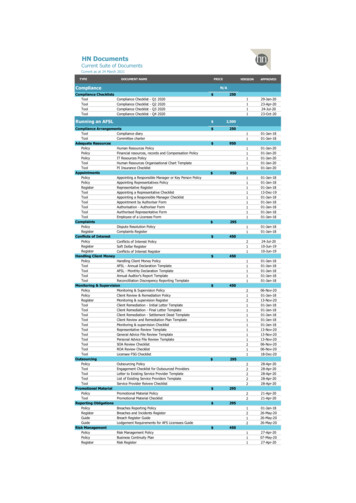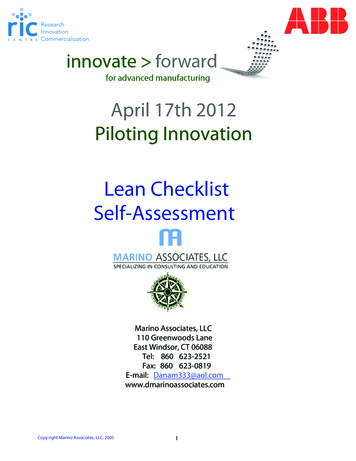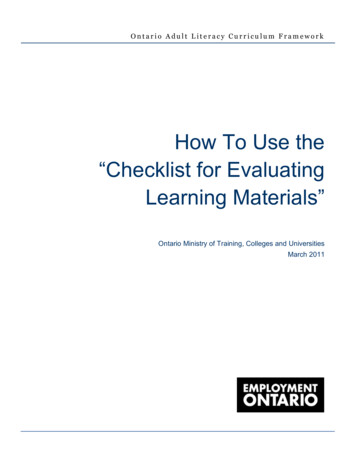
Transcription
This document contains both information and form fields. To read information, use the Down Arrow from a form field.Ontario Adult Literacy Curriculum FrameworkHow To Use the“Checklist for EvaluatingLearning Materials”Ontario Ministry of Training, Colleges and UniversitiesMarch 2011
O A L C F How to Use the Checklist for Evaluating Learning MaterialsContentsWhat is this document about? .1Introducing the Checklist for Evaluating Learning Materials .1How was the Checklist for Evaluating Learning Materials developed? .1How is the Checklist organized? .2Examining the Checklist in detail .3Describing the “Quality of Content” section.3Describing the “Potential Effectiveness as a Teaching-Learning Tool” section .3Describing the “Ease of Use (for Practitioners and Learners)” section .4Describing the “Comments” section .4The Checklist in Action: Kitchen Math Example .5Filling out the “Content” section of the checklist .5Answering the evaluative questions and providing comments .5Checklist for Evaluating Learning Materials . 19 i
O A L C F How to Use the Checklist for Evaluating Learning MaterialsWhat is this document about?How to Use the “Checklist for Evaluating Learning Materials” introduces you to the Checklist for Evaluating Learning Materials byoproviding information on its purpose and developmentodetailing the six Ontario Adult Literacy Curriculum Framework (OALCF) principles onwhich it is basedodescribing the checklist’s five sections illustrates how to use the checklist by evaluating an actual learning material provides a blank checklist for evaluating your own learning materialsIntroducing the Checklist for Evaluating LearningMaterialsWith the implementation of the new Ontario Adult Literacy Curriculum (OALCF), practitioners in theLiteracy and Basic Skills (LBS) Program will need to evaluate the extent to which their program practicessupport adult learners in a task-based and goal-directed learning environment. Specifically, as a volunteertutor, instructor, or program coordinator, you will need to evaluate your learning materials to determinetheir effectiveness within the OALCF.To help you in your work, the Checklist for Evaluating Learning Materials has been developed. Thechecklist provides a set of standard questions to evaluate learning materials—ensuring greater qualityand consistency of programming and a competency- and goal-directed program approach. You can usethe checklist to evaluate both print and non-print learning materials, such as books, workbooks, videocollections, software, and websites.How was the Checklist for Evaluating Learning Materials developed?The following six principles guided the development of the OALCF:1. Address learner needs first and foremost. The Checklist for Evaluating Learning Materialsidentifies materials according to the learner’s culture, language, and goal path. Using thechecklist will enable you to assess the match between the learning material and learner’s needs,interests, goal, and culture – helping to ensure that your programming is learner-centered,relevant, and meaningful.2. Make practitioners’ jobs easier. The Checklist for Evaluating Learning Materials will display theresults of your evaluation in an easy-to-read format. Then, both you and the learners in yourprogram can easily find learning materials that best match their needs.3. Be appropriate for, and accessible to, learners and practitioners with diverse cultural needs. TheChecklist for Evaluating Learning Materials asks you to identify the cultural group of the targetaudience for the learning material. In this way, you can easily find resources reflecting the culturalvalues and language of learners. 1
O A L C F How to Use the Checklist for Evaluating Learning Materials4. Be accountable to the public. The Checklist for Evaluating Learning Materials helps you evaluatea learning material that may already be in your delivery agency’s collection or may be a resourcethat your agency intends to buy.5. Be built on a specified, strong theoretical foundation consistent with andragogy. The Checklist forEvaluating Learning Materials uses evaluative questions that directly reflect adult learningprinciples. Specifically, the questions take into account that learners are self-directed want to be engaged in decisions affecting them have life experiences and knowledge are goal-oriented must see the reason for learning something are practical need to be treated with respect6. Be clear to learners, practitioners, the Ministry of Training, Colleges and Universities (MTCU),and other stakeholders. The Checklist for Evaluating Learning Materials makes explicit theconnection between a particular learning material and the OALCF’s competency- and task-basedprogram approach.The development of the checklist was informed by various educational and institutional sources.Specifically, the evaluative questions and the categories into which they are grouped were adapted fromMERLOT-Multimedia Education Resource for Learning and Online Teaching. You can access thisresource at http://taste.merlot.org/evaluationcriteria.html.To further understand the key concepts and rationale that informed the development of the Checklist forEvaluating Learning Materials, please read Foundations of Learning ations/OALCF Foundations of Learning Materials March 2011.pdf), available from the “Linking Learning Materials to the OALCF” web page of the OALCF website.How is the Checklist organized?The Checklist for Evaluating Learning Materials is comprised of the following five sections:1. Content2. Quality of Content3. Potential Effectiveness as a Teaching-Learning Tool4. Ease of Use (for Practitioners and Learners)5. CommentsThe blank checklist at the back of this document shows the five sections. 2
O A L C F How to Use the Checklist for Evaluating Learning MaterialsExamining the Checklist in detailThe first part of the checklist is the “Content” section. Here you identify the name of the learning materialand its cultural orientation, the goal path to which it relates, and the predominant and secondarycompetencies it supports. You also indicate the date of your evaluation.The “Content” section is followed by three sections, “Quality of Content,” “Potential Effectiveness as aLearning-Teaching Tool,” and “Ease of Use (for Practitioners and Learners).” These three categoriesorganize the 13 evaluative questions that further determine the “fit” of a learning material within theOALCF. Taken as a whole, the questions help to ensure that the learning material matches the OALCF’slearner-centred, goal-directed, competency-based, and task-based approach to programming.To answer each evaluative question, you will use the scale shown in Figure 1 to rate the learning materialfrom low to high. Low indicates a “not at all” response to an evaluative question and high indicates a“most definitely” response.LowHighFigure 1: Rating scale for use with the evaluative questionsDescribing the “Quality of Content” sectionIn the “Quality of Content” section of the checklist, you answer four evaluative questions to determine theextent to which the learning material is adult appropriate, has clear objectives, includes current, relevant,and accurate content, and is appropriate for the targeted cultural group or delivery sector. You then usethe boxes on the right side of the checklist to rate your response to each question from low to high.For example, to answer the question “Is the material appropriate for adults?”, some qualities that wouldinform a high rating are as follows: The subject is presented in a mature format Topics are of interest to adults Materials are designed so that learners can immediately apply the skills, knowledge, andbehaviours they have acquired in classConversely, some qualities that would inform a low rating are as follows: The material is presented with children’s needs and interests in mind The activities consist of “drill and kill” exercises without providing any meaningful and relevantcontext Topics do not reflect an adult lifestyleDescribing the “Potential Effectiveness as a Teaching-Learning Tool” sectionIn the “Potential Effectiveness as a Teaching-Learning Tool” section, you answer five evaluativequestions to determine the extent to which the learning material can be adapted, satisfies differentteaching and learning styles, reflects current, accepted methodology, and enables you to deliver task- 3
O A L C F How to Use the Checklist for Evaluating Learning Materialsbased learning that meets individual needs. You use the boxes on the right side of the checklist to rateyour response to each.For example, to answer the question “Does the material present options for meeting individual needs?”,some qualities that would inform a high rating are as follows: The material can be adapted to respond to the needs, interests, and goal of the learner Suggested out-of-class activities enable learners to apply what they have learned in authenticsituationsConversely, some qualities that would inform a low rating are as follows: The material provides no opportunity for learners to apply their newly acquired abilities in real-lifesituations Adaptation of the material is challengingDescribing the “Ease of Use (for Practitioners and Learners)” sectionIn the “Ease of Use (for Practitioners and Learners)” section, you answer four evaluative questions todetermine the extent to which the learning material allows you to easily identify OALCF competencies andtask groups, presents the information attractively, and supports flexibility and self-directed learning.Again, you rate your response to each question from low to high.For example, to answer the question “Does the material present information is appealing ways?”, somequalities that would inform a high rating are as follows: The layout of the material looks uncluttered; therefore it is not intimidating The use of visuals breaks up the text and helps the reader to understand itConversely, some qualities that would inform a low rating are as follows: The text is very dense, making the materials look cluttered The type is very small and difficult to read for some learnersDescribing the “Comments” sectionIn the “Comments” section, you have an opportunity to provide more detailed information about thelearning material—information that might help other practitioners or learners evaluate and selectappropriate learning materials. 4
O A L C F How to Use the Checklist for Evaluating Learning MaterialsThe Checklist in Action: Kitchen Math ExampleTo help you understand how to use the Checklist for Evaluating Learning Materials, an evaluator at anLBS delivery agency has used it to evaluate Kitchen Math, an actual learning material. Developed by LisaCampbell of the Northwest Territories Literacy Council in 2009, the Kitchen Math workbook is one of threein the Everyday Math Skills series. It is available for download at NALD (http://library.nald.ca/item/8508).We will take you step-by-step through the evaluation process.Filling out the “Content” section of the checklistDesigned for anglophone and Native learners in Northern Ontario, Kitchen Math is used in communitybased delivery agencies. Included in the workbook are activities to develop learners’ skills, knowledge,and behaviours to plan, select, purchase, and prepare food for meals – replicating the real-life tasks offeeding a family. These tasks relate primarily to competency C. Understand and Use Numbers. However,the tasks also relate to the two competencies Find and Use Information and Communicate Ideas andInformation. The workbook uses authentic examples to provide a basis for learning and practicing basicmath skills and includes activities outside the classroom to further contextualize learning.Answering the evaluative questions and providing commentsThe following pages illustrate how the evaluator answered the 13 evaluative questions for Kitchen Math.For each question, we have provided the evaluator’s rating as well as descriptions to anchor the “low tohigh” rating scale for the response. The Evaluator’s comments have also been included. 5
O A L C F How to Use the Checklist for Evaluating Learning MaterialsQuality of ContentIs the material appropriate for adults?You would give the learning material a high rating if the subject was of interest to adults the topic was relevant to activities in which adults would participate basic skills were presented in a mature format; no child-like images or concepts were present learners could immediately apply the skills they had learnedYou would give the learning material a low rating if the subject matter was presented with children’s interests, needs, and level of understanding inmind the topics were presented without context. For example, they contained isolated multiplicationdrills and spelling lists. the material indicated a grade level directly, such as a Grade 3 levelKitchen MathIs the material appropriate for adults?LowHighEvaluator’s Comments Adults who would use this material are probably interested in nutrition and inlearning the skills necessary to plan meals. The topic is relevant to adults since they need to prepare food for themselvesand their families. Lessons and activities generally pertain to a typical adult lifestyle and most canbe applied immediately. 6
O A L C F How to Use the Checklist for Evaluating Learning MaterialsQuality of ContentAre the learning objectives clear?You would give the learning material a high rating if the learning goals were clearly stated before each unit or lesson, as in “By the end of this lesson,learners will be able to . . . ” an obvious connection existed between the material being taught, the reasons for teaching it, andthe gains learners could make learners could understand and state what they were expected to learnYou would give the learning material a low rating if learners would be unclear about what they were supposed to be learning and why the materials had no reasonable pattern or flowKitchen MathAre the learning objectives clear?LowHighEvaluator’s Comments Adults who would use this material are probably interested in nutrition and inlearning the skills necessary to plan meals. The topic is relevant to adults since they need to prepare food for themselvesand their families. Lessons and activities generally pertain to a typical adult lifestyle and most canbe applied immediately. 7
O A L C F How to Use the Checklist for Evaluating Learning MaterialsQuality of ContentIs the content current, relevant, balanced, and accurate?You would give the learning material a high rating if the themes, messages, and concepts accurately reflected current social and economic realities learners could see themselves, their values, and their realities in the themes, messages, andconcepts that supported learning ideas were presented without bias factual material was correct what was being taught was something learners could useYou would give the learning material a low rating if the themes, topics, and messages were outdated and did not reflect current beliefs, socialstructures, or realities obvious biases existed the material had mistakesKitchen MathIs the content current, relevant, balanced, and accurate?LowHighEvaluator’s Comments Nutrition is an important consideration in this workbook, reflecting currentglobal health concerns. Learners are introduced to modern information gathering and sorting tools forgood health, such as the Body Mass Index (BMI) and food labels. The worksheet topics are timely, accurate, and reflect the interests andrealities of individuals who live in the North. Prices listed accurately reflect food prices in the North. Recipes are provided and learners are encouraged to use them at home. The material has more drills than task-oriented lessons. 8
O A L C F How to Use the Checklist for Evaluating Learning MaterialsQuality of ContentIs the content appropriate to the needs of the culturalgroup or delivery sector?You would give the learning material a high rating if the subject matter and the way it was presented were sensitive to the socio-economic, cultural,and linguistic differences of learners concepts and messages were addressed with specific traditions or beliefs in mind learners could relate to what was being taught and the vehicle for teaching itYou would give the learning material a low rating if learners could not relate to or understand the subject matter obvious cultural biases existed learners’ traditions and cultural norms were misrepresentedKitchen MathIs the content appropriate to the needs of the cultural group ordelivery sector?LowHighEvaluator’s Comments The material introduces the concept of nutrition, an important consideration forall individuals, regardless of their cultural or linguistic backgrounds. Marginalized groups are at greater risk for poor health, so information toimprove their health is advantageous. Recipes make reference to a typical Northern diet. Much of the content in the first section was adapted from an anglophoneresource; therefore, concepts and references within it reflect the anglophoneculture. 9
O A L C F How to Use the Checklist for Evaluating Learning MaterialsPotential Effectiveness as a Teaching-Learning ToolDoes the material present opportunities for task-basedlearning?You would give the learning material a high rating if skills were developed and taught as they related to the tasks the learner was required tocomplete the material emphasized completing tasks rather than on completing “skills and drills” orcompleting worksheets the tasks that learners completed reflected their immediate needsYou would give the learning material a low rating if the material developed skills, but indicated no purpose for using them skill development was mostly in the form of drills, repetitive worksheets, or cloze exercises learners could not apply the skills they were learning in their livesKitchen MathDoes the material present opportunities for task-based learning?LowHighEvaluator’s Comments Kitchen Math develops basic math skills by applying them to the tasks involvedin meal preparation—tasks that learners completed outside the class. Learners are presented with opportunities to learn about related tasks thatinvolve more than just math skills, such as making a shopping list, planning aworkshop, or searching for food information on the Internet. Kitchen Math is a workbook that requires a great deal of pen- and-paper work;however, the author includes extended learning activities that are task-based. 10
O A L C F How to Use the Checklist for Evaluating Learning MaterialsPotential Effectiveness as a Teaching-Learning ToolDoes the material present options for meeting individualneeds?You would give the learning material a high rating if the material provided suggestions for alternate activities or approaches lessons were set up so learners could advance at their own pace, even if they skipped ahead orspent more time on a particular unitYou would give the learning material a low rating if the material was difficult to modify no opportunities existed for learners to apply what they had learned in authentic situationsKitchen MathDoes the material present options for meeting individual needs?LowHighEvaluator’s Comments Kitchen Math is predominantly a pen-and-paper activity workbook; however,opportunities exist for learners to apply the skills they are learning in practicalsituations that may be more suited to their individual needs. The material is somewhat personalized and could be altered by thepractitioner. The material provides opportunities for discussion, as the topics are timely. Practitioners can pick and choose activities or worksheets that best suit theneeds and skills of the individual learner. 11
O A L C F How to Use the Checklist for Evaluating Learning MaterialsPotential Effectiveness as a Teaching-Learning ToolDoes the material satisfy the various teaching and learningstyles?You would give the learning material a high rating if lessons or tasks could be modified to address learners’ individual needs. For example, thepractitioner or another learner could read the directions aloud. lessons used multiple approaches to accommodate various learning stylesYou would give the learning material a low rating if lessons were presented in only one way, for example, with only written instructions the material did not include a visual or an audio componentKitchen MathDoes the material satisfy the various teaching and learning styles?LowHighEvaluator’s Comments The material is presented in only a couple of formats; it uses only text andgraphics. A practitioner or classmate can act as a scribe and help a learner complete thewritten portions orally. 12
O A L C F How to Use the Checklist for Evaluating Learning MaterialsPotential Effectiveness as a Teaching-Learning ToolCan the material be adapted to meet the needs of thetargeted cultural group or delivery sector?You would give the learning material a high rating if lessons or tasks could be modified to address the social and economic differences of learners lessons or tasks could be changed to respond to the cultural and linguistic differences of learnersYou would give the learning material a low rating if practitioners would have difficulty modifying lessons or tasks to respond to the social andeconomic differences of learners lessons or tasks could not be changed easily to respond to the cultural and linguistic differencesof learnersKitchen MathCan the material be adapted to meet the needs of the targetedcultural group or delivery sector?LowHighEvaluator’s Comments Kitchen Math is predominantly a pen-and-paper workbook; therefore,alterations to content are limited to the amount of changes the practitioner canor wants to make. A learner who is not comfortable with pen-and-paper activities would bechallenged by this material. 13
O A L C F How to Use the Checklist for Evaluating Learning MaterialsPotential Effectiveness as a Teaching-Learning ToolDoes the content reflect current and acceptedmethodology?You would give the learning material a high rating if lessons reflected the various notions about how adults learned lessons were developed with learner input or were learner-directed lessons avoided methods, such as cloze exercises, that did not match activities that would becarried out beyond the classroom lessons relied on the learner’s prior knowledge for building new skillsYou would give the learning material a low rating if the material did not reflect current practices and concepts associated with adult learning lessons did not take into consideration the learner’s prior knowledge or skillsKitchen MathDoes the content reflect current and accepted methodology?LowHighEvaluator’s Comments Kitchen Math is mainly a pen-and-paper workbook, a format that is usually lesseffective for adult learners. The workbook author has not recognized the importance of setting up activitiesoutside the classroom to practice newly learned skills and to allow learners totake charge of their learning. 14
O A L C F How to Use the Checklist for Evaluating Learning MaterialsEase of Use (for Practitioners and Learners)Are OALCF competencies and task groups easilyidentified?You would give the learning material a high rating if OALCF competencies and task groups could be clearly identified the competencies and task groups of the OALCF were statedYou would give the learning material a low rating if it was unclear what competencies and task groups could be aligned with the learning materials the competencies and task groups of the OALCF were not statedKitchen MathDoes the content reflect current and accepted methodology?LowHighEvaluator’s Comments The title of the book clearly indicates that it will be dealing with numbers, so ithelps learner work with OALCF competency C. Understand and Use Numbersand its task groups. After reviewing the material, it is obvious that the learning material helps todevelop other competencies. 15
O A L C F How to Use the Checklist for Evaluating Learning MaterialsEase of Use (for Practitioners and Learners)Does the material present information in appealing ways?You would give the learning material a high rating if the material was attractive and uncluttered the material looked easy to read and understand topics were current and of interest to adults materials included a variety of activities that challenged the learnerYou would give the learning material a low rating if adults did not enjoy working with the material since it was unattractive and cluttered the text did not look easy to read and understand, making it appear intimidatingKitchen MathDoes the material present information in appealing ways?LowHighEvaluator’s Comments Kitchen Math comes across visually as a typical workbook with lots ofinstructions and drills. The variety of ideas for activities outside the classroom is interesting and likelyto appeal to an adult audience. 16
O A L C F How to Use the Checklist for Evaluating Learning MaterialsEase of Use (for Practitioners and Learners)Does the material provide flexibility in its use?You would give the learning material a high rating if it did not prescribe an order for teaching the material allowed the practitioner to use different media with the tasks the material allowed the practitioner to adapt it to meet learners’ needs, interests, and goalsYou would give the learning material a low rating if the learner had to use the material from start to finish the material could only be used in one format, such as paper the context of the task could not be changed to meet the needs and goals of learnersKitchen MathDoes the material provide flexibility in its use?LowHighEvaluator’s Comments The pen-and-paper approach may limit some learners. The materials provide learners with an opportunity for outside class activities topractice what they have learned in class. Learners or practitioners can pick and choose worksheets according to thelearner’s prior knowledge and skill levels. The practitioner can use the worksheets as a guide to help create moresuitable, task-based activities, based on the learner’s needs and goal. 17
O A L C F How to Use the Checklist for Evaluating Learning MaterialsEase of Use (for Practitioners and Learners)Does the material support self-directed learning?You would give the learning material a high rating if the material supported learners working on their own it provided a lot of opportunity for learner inputYou would give the learning material a low rating if learners had to rely on the instructor to complete the lessons the material did not allow for learner inputKitchen MathDoes the material support self-directed learning?LowHighEvaluator’s Comments The “Math Projects” pages encourage learners to practice what they havelearned by completing activities outside the classroom. Answer pages in the back of the workbook support learners working on theirown. Learners do not have to rely on practitioner support to get through theactivities. 18
O A L C F How to Use the Checklist for Evaluating Learning MaterialsChecklist for Evaluating Learning MaterialsName of Learning MaterialDate of Evaluation1. ContentAnglophoneDeafFrancophoneNativeCultural GroupEmploymentApprenticeshipSecondary SchoolCreditPostsecondaryIndependenceGoal PathA. Find and UseInformationB. CommunicateIdeas andInformationC. Understandand UseNumbersD. Use DigitalTechnologyE. ManageLearningF. Engage es2. Quality of ContentLowHighIs the material appropriate for adults?Are the learning objectives clear?Is the content current, relevant, and accurate?Is the content appropriate to the needs of the targeted cultural group ordelivery sector? 19
O A L C F How to Use the Checklist for Evaluating Learning Materials3. Potential Effectiveness as a Teaching-Learning ToolLowHighLowHighDoes the material present opportunities for task-based learning?Does the material present options for meeting individual needs?Does the material satisfy the various teaching and learning styles?Can the material be adapted to meet the needs of the targeted culturalgroup or delivery sector?Does the content reflect current and accepted methodology?4. Ease of Use (for Practitioners and Learners)Are OALCF competencies and task groups easily identified?Does the material present information in appealing ways?Does the material provide flexibility in its use?Does the material support self-directed learning?5. Comments 20
introduces you to the Checklist for Evaluating Learning Materials by o providing information on its purpose and development o detailing the six Ontario


